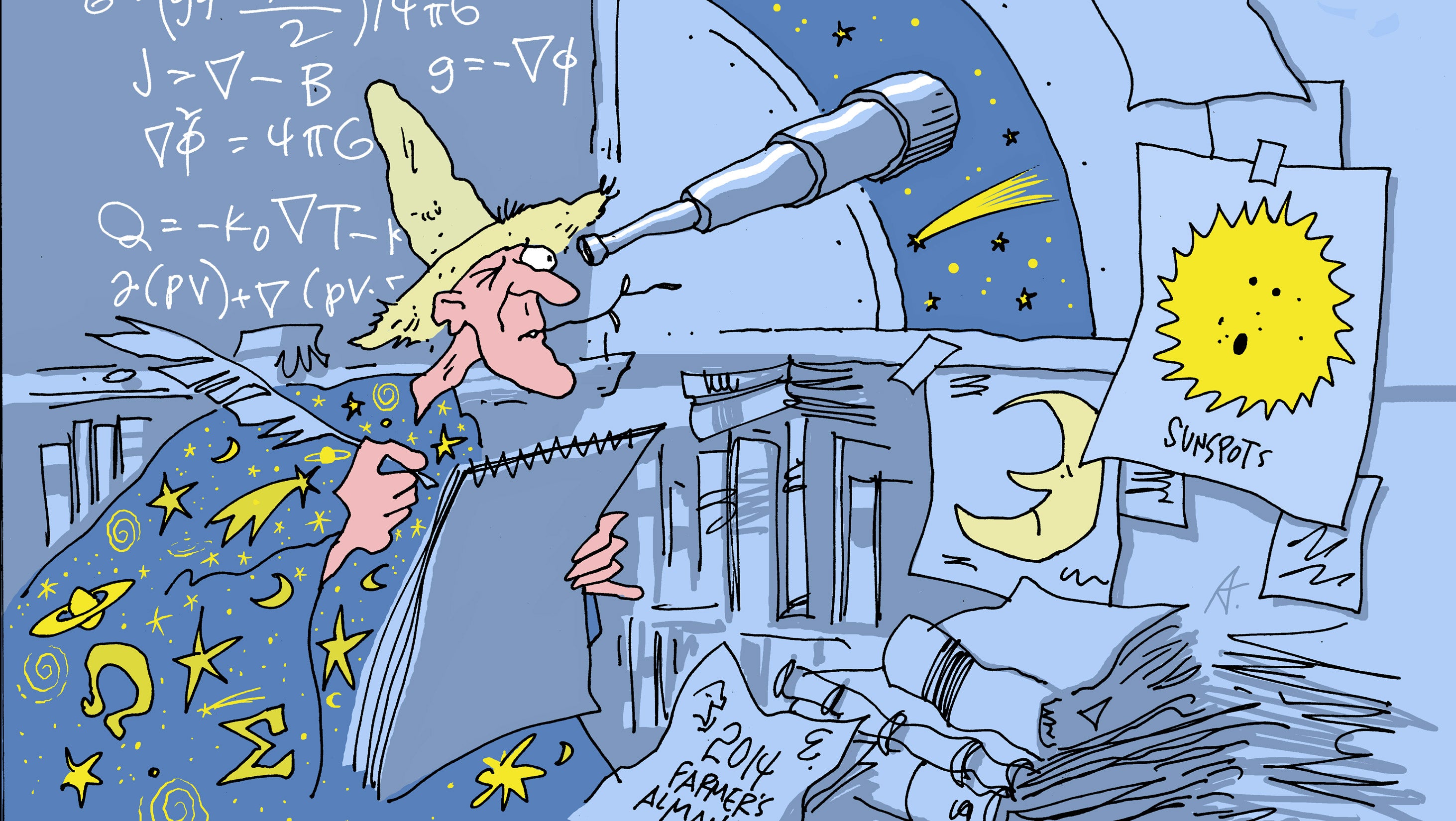How did the Farmers’ Almanac ‘nail’ this winter’s forecast? That’s a secret
Listen
(Illustration by Tony Auth)
With secret formulas, a weather “prognosticator” and nearly 200 years of history, the Farmers’ Almanac has its own take on forecasting.
With secret formulas, a weather “prognosticator” and nearly 200 years of history, The Farmers’ Almanac (not to be confused with The Old Farmer’s Almanac) definitely has its own take on weather forecasting.
When this year’s edition came out last August, it called for a chilly, snowy winter.
Yeah, sounds about right.
We caught up with editor Peter Geiger to see how the Farmers’ Almanac does its thing.
Below is an edited transcript of our conversation.
Going into this winter, what was your forecast and when did you make it?
Well, first of all, we do our weather two years in advance. When we released the almanac on Aug. 26, what we said was it was going to be a very, very cold winter. We used the words “bitterly cold,” “piercingly cold,” “bitingly cold” and a lot of snow to go with it. And that was pretty much for the entire country, I would say, with the exception of the Northwest. As it turns out, that’s exactly what it was, and it just keeps on coming. It’s been an incredible winter for the cold. When we released the almanac back in August, the big deal was the Super Bowl prediction, where we said we thought there would be a storm during the Super Bowl.
And you just missed that one, though, right?
We did say somewhere in the almanac that we might miss it by a day or so. But where the Super Bowl took place, which was outdoors, it started to snow about two hours after the game, and within 10 or 12 hours they shut down New Jersey with a state of emergency. We nailed that one so close that it’s pretty much what we said it would be. It just came in a few hours after we said.
So the obvious question is, two years ahead of time, how are you making these forecasts? What’s the science behind long-term weather forecasting?
In our case, the almanac was started in the early 1800s, 1818. Our first editor was David Young and he wanted to predict weather for farmers. But he was a mathematician, an astronomer and a calculator, so he developed a mathematical formula, which our prognosticator applies to sun-spot activity, planet positions, the affect the moon has on the earth. That allows us to do our weather two years in advance. It’s a formula that has been passed down. In 197 years, there have been only seven people that have done the forecasting.
So I have a question about that: Who is Caleb Weatherbee? Are you Caleb Weatherbee?
Well, I’m not Caleb. In fact, Caleb is a pseudonym for somebody who does the weather for us. Caleb has been doing the weather for us for many years and prior to that everybody who’s done it has done it for 25 to 40 years, and it works out very well for us.
I understand that Caleb is at an undisclosed location. You won’t even say where he is?
Right. That is true. We keep him under close wraps.
Critics of your forecasts say that they’re vague and pseudoscientific. What do you say to that?
I don’t think that they’re vague. We’re doing the weather two years in advance and we have it in the publication. People can go online and see for themselves what we say. I mean, I can’t say it’s going to start to snow or rain in Philadelphia at two in the morning and end at six in the morning, but I might be able to tell you that it’s going to be a heavy storm.
I think, quite frankly, that this year we nailed it — both in terms of our long-range prediction, which was very cold and snowy, and the day-to-day. Some of the storms that you’ve had [in Philadelphia] are storms that we called for.
Over almost two centuries, what explains the longevity and continued interest in what the Farmers’ Almanac does?
We’re not a weather book. Even though we talk about weather, the Farmers’ Almanac really is a guide to good living. It really is an opportunity for people to look at a publication and then figure out how can they grow their own food, how they can raise chickens at their house if they want to, or just neat little ideas. Overall, we’re trying to be good to the Earth; we’re trying to be good to each other. The almanac is a resource for people who want to know how to do things and do if for themselves.
WHYY is your source for fact-based, in-depth journalism and information. As a nonprofit organization, we rely on financial support from readers like you. Please give today.



